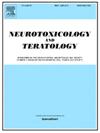Autism spectrum disorder-like behaviors in developing zebrafish exposed to particulate matter
IF 2.8
3区 医学
Q3 NEUROSCIENCES
引用次数: 0
Abstract
Autism spectrum disorder (ASD) is a group of neurodevelopmental disorders that can impact communication and social behaviors. Evidence suggests that the causes of ASD are likely a combination of genetic and environmental factors, such as air pollution. Particulate matter (PM) is the solid and liquid portion of air pollution that can vary in size and has been associated with many health impacts, including cardiorespiratory impacts, and has more recently been found to be associated with the prevalence of ASD. However, little is known about the phenotypic presentations of this association between PM and ASD, therefore, the zebrafish (Danio rerio) model was employed to study behaviors often associated with ASD as a result of PM exposure. Zebrafish larvae were exposed for a total of 5 days to PM standard reference material (SRM1649b) and a commonly used home remedy, melatonin, beginning at 6 h post-fertilization and various behavioral assays were performed on subsequent days for a total of 13 days. Observed and quantified behaviors were compared to a positive control, valproic acid (VPA). Generally, PM exposure did not elicit behavior resembling that of VPA exposure and the interactions between PM and VPA did not induce additive or synergistic behavioral patterns, as expected. Melatonin supplementation did not ameliorate most of the observed behavioral impacts of PM or VPA exposure. These results have prompted additional questions about the phenotypic presentations of ASD as a result of PM exposure and contribute to growing knowledge about disease-environment interactions.

暴露在颗粒物质中的发育中的斑马鱼的自闭症谱系障碍样行为
自闭症谱系障碍(ASD)是一组影响沟通和社会行为的神经发育障碍。有证据表明,自闭症的病因可能是遗传和环境因素(如空气污染)共同作用的结果。颗粒物(PM)是空气污染的固体和液体部分,其大小各不相同,与许多健康影响有关,包括心肺影响,最近发现与泛自闭症障碍的患病率有关。然而,人们对PM与ASD之间的这种关联的表型表现知之甚少,因此,我们采用斑马鱼(Danio rerio)模型来研究PM暴露通常与ASD相关的行为。从受精后6小时开始,斑马鱼幼虫暴露于PM标准参比物质(SRM1649b)和常用的家庭药物褪黑激素共5天,并在随后的几天进行各种行为分析,共13天。观察和量化行为与阳性对照丙戊酸(VPA)进行比较。一般来说,PM暴露不会引起与VPA暴露相似的行为,PM和VPA之间的相互作用也不会像预期的那样诱发相加或协同行为模式。褪黑素补充并没有改善大多数观察到的PM或VPA暴露的行为影响。这些结果引发了关于PM暴露导致的ASD表型表现的其他问题,并有助于增加对疾病-环境相互作用的了解。
本文章由计算机程序翻译,如有差异,请以英文原文为准。
求助全文
约1分钟内获得全文
求助全文
来源期刊
CiteScore
5.60
自引率
10.30%
发文量
48
审稿时长
58 days
期刊介绍:
Neurotoxicology and Teratology provides a forum for publishing new information regarding the effects of chemical and physical agents on the developing, adult or aging nervous system. In this context, the fields of neurotoxicology and teratology include studies of agent-induced alterations of nervous system function, with a focus on behavioral outcomes and their underlying physiological and neurochemical mechanisms. The Journal publishes original, peer-reviewed Research Reports of experimental, clinical, and epidemiological studies that address the neurotoxicity and/or functional teratology of pesticides, solvents, heavy metals, nanomaterials, organometals, industrial compounds, mixtures, drugs of abuse, pharmaceuticals, animal and plant toxins, atmospheric reaction products, and physical agents such as radiation and noise. These reports include traditional mammalian neurotoxicology experiments, human studies, studies using non-mammalian animal models, and mechanistic studies in vivo or in vitro. Special Issues, Reviews, Commentaries, Meeting Reports, and Symposium Papers provide timely updates on areas that have reached a critical point of synthesis, on aspects of a scientific field undergoing rapid change, or on areas that present special methodological or interpretive problems. Theoretical Articles address concepts and potential mechanisms underlying actions of agents of interest in the nervous system. The Journal also publishes Brief Communications that concisely describe a new method, technique, apparatus, or experimental result.

 求助内容:
求助内容: 应助结果提醒方式:
应助结果提醒方式:


